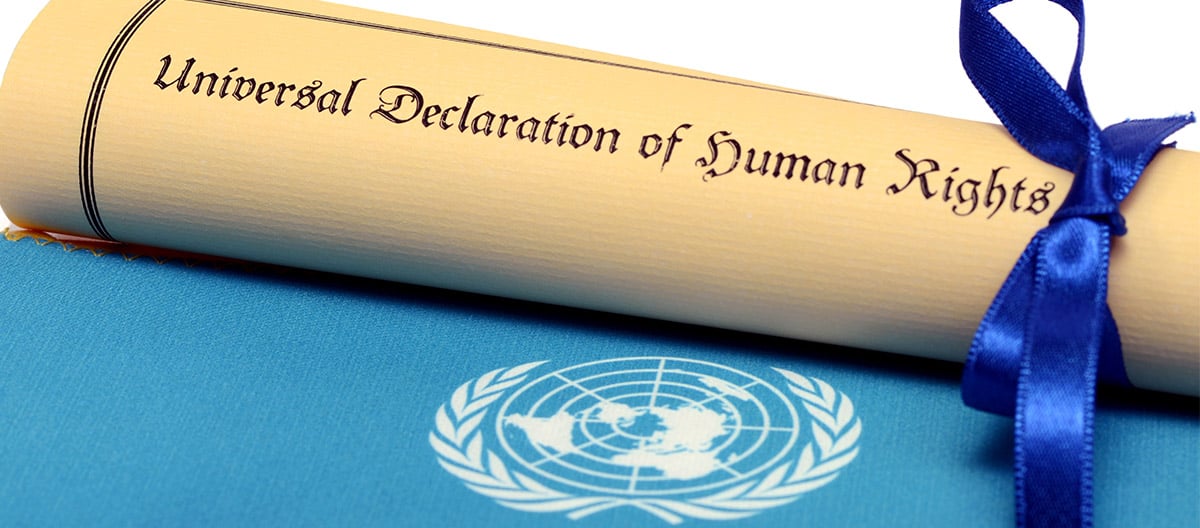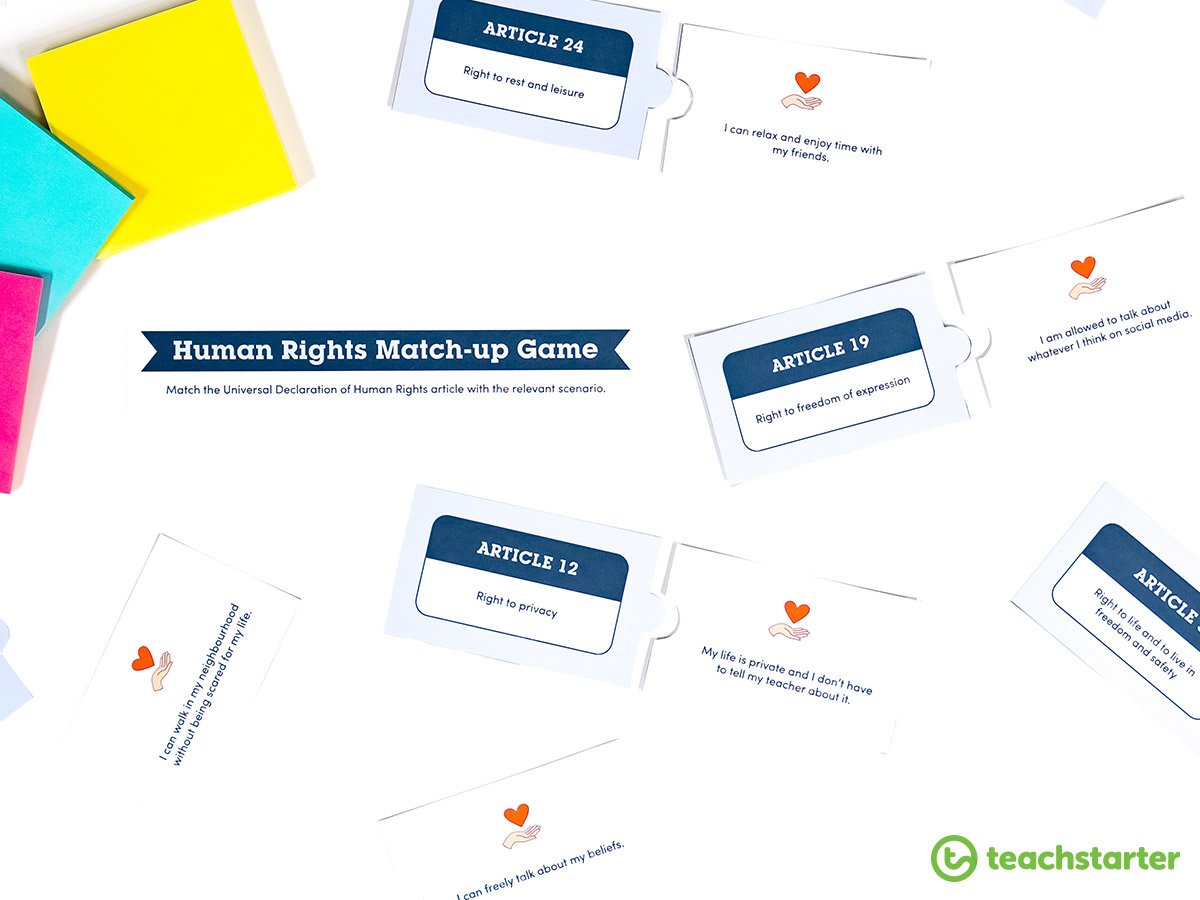As another year draws to a close, it can often be hard to think of something poignant to leave your class, something meaningful for them to take with them as they progress into another year of schooling. With the holiday season looming it can often be too easy to get caught up in the magic of gifts, vacations and, depending on where you are from, long summer nights or warm fireside repose. It’s a time when considering our fellow humans should be tantamount, and a very timely time of year to celebrate International Human Rights Day, which is celebrated on the 10th of December.
Educating our young people about human rights is a way of protecting the fundamental freedoms many of us take for granted every day. Knowledge of human rights and the laws that protect all people gives the students the skills they need to promote, defend and apply human rights in daily life.
This blog highlights a series of activities designed to educate, inform, enlighten and embolden them with knowledge. From ages five to fifteen there are a variety of activities you can do with the class which will give them a firmer grasp of what human rights are, why they are important and how to personally uphold and fight for what they represent. Let’s face it, in the wise words of Whitney Houston…
“I believe the children are our future. Teach them well and let them lead the way.”

The Universal Declaration of Human Rights Classroom Activity
Let’s take the content straight from the horse’s mouth. The Universal Declaration of Human Rights was developed as a common standard of achievements for all peoples and all nations.
A document consisting of a mere 30 articles came into existence which would fundamentally change the way people viewed human rights on an international scale. Since then the rights have been expanded on in other binding agreements.

The Activity: The Human Rights Magical Fruit Tree
Fruit trees typically produce only one kind of fruit, but a magical tree might produce a variety of unique and diverse fruits, much like the unique and diverse peoples of our earth.
In this activity, the students use the Create Magical Fruits Template to decorate unique fruit shapes to add to a Human Rights Magical Fruit Tree.
- Use classroom craft supplies to create a wall display of a tree complete with multiple branches and leaves.
- The students are to decide as a class, the human rights that they think all people need to live in dignity and justice.
- From the list, assign one human right to each student (or teams of students) to be included as part of their magical fruit design.
- When the designs are complete and the human right is written on the fruit, it can be added to the Human Rights Magical Fruit Tree.
As a follow-up activity, the class can match the fruits with articles of the Universal Declaration of Human Rights and write the number of the article next to each magical fruit. A copy of the Universal Declaration of Human Rights can be found on the United Nations Website.
Amnesty International Classroom Activity
Amnesty International is an international, non-governmental organisation based in London. Their stated mission is to campaign for…
“…a world in which every person enjoys all of the human rights enshrined in the Universal Declaration of Human Rights and other international human rights instruments.”

The Activity: The Human Rights Matching Game
There are 30 different articles in the Universal Declaration of Human Rights and it can often be difficult to understand how these articles relate to real-world events and situations.
- Have the students watch the Amnesty International clip What Are Human Rights?
- As a class, discuss the themes contained in the video. Use a mind-map on the board to record information relevant to human rights.
- Split the class into groups of 3 or 4 and distribute the Human Rights Matching Game cards (each group should receive a copy of all the cards).
- The students must then match the scenarios with the applicable human rights articles.
- Once each group has matched all the cards with an article, discuss the responses. Responses may vary, however, an answer sheet has been provided as a reference.
The matching game contains only eight of the 30 articles of the Universal Declaration of Human Rights.
As a follow-up activity, have the students create their own cards to find ways to link the other articles of the Universal Declaration of Human Rights to everyday activities in their lives.
Community Members Classroom Activity
All communities have a certain percentage of people who have not always been able to afford the rights the Universal Declaration of Human Rights gives.
People from other countries, people who have lived through times of war and people whom society had shunned at one time or another are among many other demographics for whom the Universal Declaration of Human Rights holds a special meaning.

The Activity: Community Guest Speaker
Inviting a guest speaker to visit the classroom can often be an eye-opening and more personal way to introduce various human rights concepts to the students. Along with discussions on language and culture, historically there are many cases where the current understanding of human rights did not apply to certain communities.
- Plan ahead by discussing with your class each student’s heritage.
- Have the students complete a family tree using the Family Tree Worksheet. Where possible the students can add extra information about family members’ cultural or historical background ie. nationality, religion, ethnic group, profession and so on.
- Decide whether a particular member of a student’s family would be suitable as a speaker, or research a local community member who may have different perspectives on human rights.
- Prepare the students a day or two before. You can do this by brainstorming questions that they can ask the guest speaker.
- Always have the students present the guest a thank-you gift. A good idea is to either have one already made by the students to give to the speaker. Also, follow up with a handwritten thank you note or card from the class.
UN Declaration of the Rights of the Child Classroom Activity
The United Nations Declaration of the Rights of the Child outlines, in language applicable for primary school students, the rights of all children in the world as defined by the UN. Our United Nations Declaration of the Rights of the Child Flashcards, outline each of the Rights of the Child.

Activity: Deconstruct YOUR Rights
In this activity, the students are tasked with a jigsaw collaborative learning task. In groups, the class will deconstruct one of the United Nations Declaration of the Rights of the Child and then present a poster, flyer, fact sheet or digital presentation to the class.
- Organise the class into groups of two or three (or whatever suits your cohort) so there are 10 groups.
- Distribute the United Nations Declaration of the Rights of the Child Flashcards, one for each group.
- In their teams, the students are tasked with creating material which will be given to the rest of the class to teach them about their particular right.
- To piece the jigsaw task together, as each group is presenting their children’s right, the rest of the class should take notes in their books.
- Show the class the YouTube clip United Nations Conventions on the Rights of the Child. Discuss how the United Nations Declaration of the Rights of the Child has progressed over the years to its present form, the Conventions of the Rights of the Child.
- On the board, begin three mind maps with the central bubbles being Dignity, Equality and Respect. From what the students have learned, brainstorm what these words now mean to the class.
As a follow-up activity, have the class look at the new simplified 42 articles of United Nations Convention on the Rights of the Child. Discuss the additions and changes and how they have improved upon the original 1924 document.
International Human Rights Day and the Nobel Peace Prize
On December 10 the world commemorates Human Rights Day. Also on this day are the Nobel Peace Prize celebrations and the presentation of the award.

Activity: Classroom Peace Prize
The idea of being a peace advocate is important for all students and is something which should be encouraged, recognised and rewarded in the classroom.
In this activity, each student is to prepare an acceptance speech for a Classroom Peace Prize to be presented at a mock awards ceremony. The students can pick from one of the following award categories to base their acceptance speech on.
- Altruism: showing selfless concern for others
- Care: desires to help people
- Compassion: feeling and showing sympathy and concern for others
- Consideration: thinking of others
- Faithfulness: being loyal
- Impartiality: treating all persons equally; fair and just
- Kindness: thoughtful, caring
- Politeness: exhibiting good manners
- Sincerity: being totally honest
In this activity, the students will take part in a mock awards ceremony in which each class member is a winner.
- Explain to the students that each individual is capable of showing at least one of the above personality traits. Give the class some time to discuss and finally choose the trait which is most suited to them.
- Display the Writing a Speech Poster on the board or monitor and discuss the structure of speech writing.
- Have the students plan, draft and edit their speeches. As their speech will be an informative text, you may like to hand out the Simple Informative Texts – Writing Scaffold.
- Choose from the Certificates and Awards collection on the Teach Starter website for an award theme best suited to this task. Ensure you have enough for each class member.
- Set aside enough time for each student to present their speeches. Explain to the class the rules to follow when someone is presenting to the class. Have each student present their speeches in front of everyone. For any students who are uncomfortable with a class presentation, give the option to have a fellow student read their speech or to have the teacher do it for them. This is not encouraged, however, as giving speeches is an important skill to practice and also a crucial element in the curriculum.
- Present all the awards once all students have completed their speeches.
As a follow-up activity, research some Nobel acceptance speeches on YouTube to show your class. Discuss with them what has made each speech effective (or not) and make some comparisons with the speeches heard in the class.
Final Words from Kristian
A solid education in human rights will allow your students to appreciate the rights they have and allow a culture of respect, to develop in the classroom. After all, is this not something we, as teachers, are constantly trying to develop in our students?







Comments